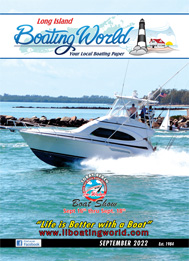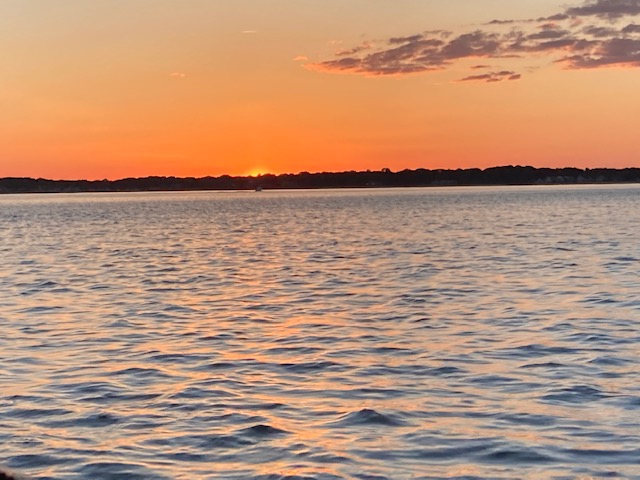
So far, after all the work I have done on the boat, it’s been a very good summer on the boat. Swimming and cruising on the bay have been an uneventful and pleasant experience. I have only had to make a couple of adjustments on one engine when one of the return line fittings loosened up creating a very small fuel leak and causing a slight case of hard starting as that leak allowed the fuel system to lose the prime. Once that fitting was tightened up the problem was solved.
Early in June, I read that the “Strawberry Super Moon “would be rising on Tuesday, June 14. We decided that it would be worth seeing and headed out on Peconic Bay to have dinner and watch the sun go down at 8:27 PM and the moon rise at 9:17 PM. It was a beautiful cloudless night with no wind, the water was a sheet of glass.
It has been a while since I have been out at night for a few reasons. There has been a significant increase in the lighting used by the homes by the entrance to the creek our marina is located in. The buoy lights are lost in the background lighting making it very difficult for me to find the entrance. But the biggest problem for many of the boaters on the Peconic face is the tremendous increase in unmarked fish trap floats.

Originally when I moved our boat out there from Patchogue there were very few of these. Recently there have been a number of areas dedicated to oyster farming and they seem to be very close to the channels. If you stay on course from buoy to buoy without taking some of the shortcuts it should be safe. The biggest problem is the strings of traps set out in the bay where most boats operate. I have hit two in the last few years. As the season goes on there are less and less of them around, maybe as unaware boaters pick them up in the propellers.
Anyway, on the night of the super moon, I noticed a long run between our marina and our dinner anchorage that was clear of any floats. So, after we ate our dinner and the time was getting closer to sunset and moon rise, we started cruising the few miles back and forth in the float-free zone! The sunset was spectacular and after that, we cruised slowly eastward and then west waiting for the moon to rise.
At roughly 9:17, from our vantage point south of Mattituck we saw the night sky turn a strawberry color as the moon broke the horizon over Southampton. It was well worth the wait and a beautiful sight to see. We took a slow cruise back to the marina and called it a night.
I have noticed that the water has been very clean so far this year and filled with baitfish. I see schools of spearing and bunker on the bay and even filmed a school of larger bunker right in the slip next to me at the marina. We have been “swimming with the fishes” by Robins Island and have witnessed bait being attacked from below and from above as osprey, terns and other birds have taken advantage of this bounty.
All this beauty has also given us a few tense moments which lead me to my next subject. Training. Can you safely ask a member of your crew to handle the boat? Have you ever done this under less than perfect circumstances? Do you assume that they understand what you are asking them to do? In your mind, even a simple task could be something that a crew member cannot do safely, and in bad conditions that can be a problem.
I have been operating boats since I was 12 or so. I spent four years in the Coast Guard as an engineer and coxswain of search and rescue boats. I held my captain’s license for over thirty years and worked as such. I am guilty of assuming that my crew could do what I may think is a simple task in poor conditions and it came close to making a bad situation worse. I like running the boat. I run it a certain way and when I ask my family if anyone wants to operate the boat they say no, no problem because I like running her. It’s not a good way to go about it though.
The other day we went out to raft up with some old friends. We had a great time talking and enjoying each other’s company and a beautiful day on the protected side of the island. From where we anchored you could not tell the wind was gusting over twenty knots or so.
When it was time to head home our friends departed first while we put away the tables and sunshades and all the gear you need while rafted up. I took it easy as the engines warmed up and then took it up to sixteen knots into a three-foot chop off the port bow. Not pushing the boat but still taking plenty of spray over the cabin. I have three hatches on the forward cabin and had covers made a few years back. I usually leave them on and never once had one come loose. Until then. As soon as I saw the cover coming loose, I slowed down to roughly ten knots and told my first mate to take the helm and keep her heading into the seas.
I went forward along the starboard side, it was as they say “a little nautical” getting to the bow. As I was lying on the cabin top, I started getting hit with more spray, and then some solid water. We were no longer going into the seas but had turned sideways to the waves exposing us to broadsides of those short but steep seas. I took the hatch cover in my hands and started heading back down the starboard side. I was having a hard time holding on and actually wondered what would happen if I fell in?
I made it safely to the cockpit and took control of the boat, my wife was somewhat upset by what she had witnessed and we have talked about it more than once over the last few days. We have come up with a solution, training. Things that we, as experienced captains, do without even thinking about it are not the course of action an untrained person would do, or be expected to do.
